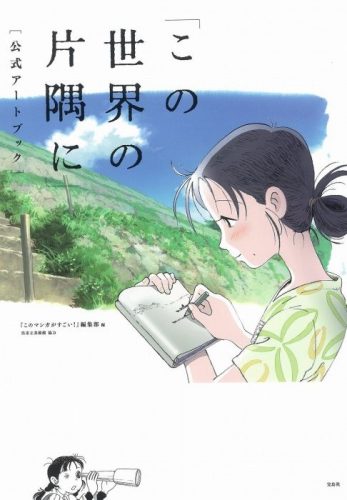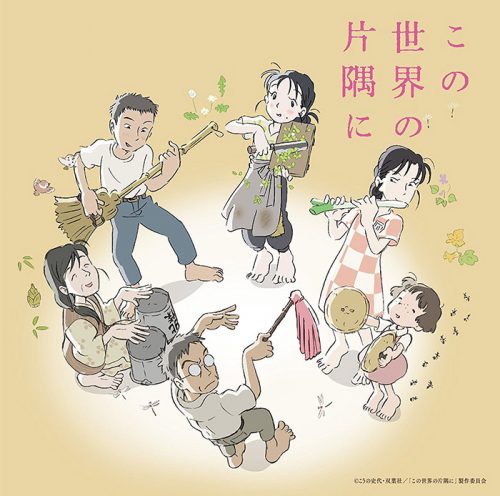
Sunao Katabunchi is known for directing the Black Lagoon TV series and movies such as Mai Mai Shinko to Sennen no Mahou, a film for young audiences. He has proven his skill to appeal to adult and young audiences, but his work on In This Corner of the Movie is a surprising melding of the two.
In This Corner of the World is a film adaptation of a manga. Taking place during World War II, the film follows Suzu Urano, a girl who marries into a new family and moves to Kure, a small town near Hiroshima. As her years in this new town pass, the date grows closer towards an inevitable closing, the bombing of Nagasaki and Hiroshima.
In this article, we will be discussing how the film uses pacing/time to depict freedom, Suzu’s hobby to create segmentation, and cues of the approaching war to unite light-hearted visuals with a serious subject.
Art and Segmentation: Reality and Fantasy Intersect
From the beginning, the film associates Suzu’s childhood with her art. Several scenes from her past where she draws help establish this, especially her portrait of the clear sea. As the film moves forward, she marries into a new family, and her husband, an enlistee of the navy, supports her hobby. The implication is two-fold: one, he wants to be a good husband and two, he wants to have something support her during his absence.
With this context, we start to see how art is used in the film to support and remind Suzu of what she loves. This sets up a juxtaposition, a segmentation of past and present, but also segmentation of physical and metaphorical space.
This is why the film is so playful with its visuals. It will often substitute reality with fantasy. Foreground and background are given distinction with a different art style and coloring. Characters from Suzu’s imagination will walk through her world. The film even shows a brush painting war scenery--this happens during the initial bombing of Kure.
How the War Inches Closer: Subtle Cues without Exposition
When the film shifts from “the war is far” to “the war is at home”, the appearance of art changes. It becomes a depiction of weapons, the military police, and propaganda. It occupies all parts of Suzu’s life, even invading the shoreline. The ocean she once drew is now filled with war boats. At this point, the art is still very coherent. However, Suzu’s perspective on the world, beautiful like a canvas, gets changed in one day.
After an intense bombing, Suzu leaves hand-in-hand from a shelter with Keiko’s daughter, Harumi. As they walk towards their home, they are on a long stretch of road, the town on the left, and the ocean on their right. In the distance, the soldiers warn Suzu about how bombs can have a delayed explosion. Just as Suzu notices the hole in the ground, she notices Harumi is close, and in that instant, an explosion.
Suzu’s right hand is gone, and with it, the person she was holding. As she wakes up, her thoughts compile in a swarm of echoes, filling her mind with guilt. The shot of the scene has her looking closely at her right hand, and the world distorts around her like a terrible portrait. Suzu can no longer see the world the same way. War is now closer than ever. It’s in her mind.
Pacing and Time: How the Good Days Fly
In This Corner of the World is a 2-hour film. The initial scenes go by quickly, supported by scenes that transition quickly like Suzu’s jump from childhood to adulthood with marriage, Suzu’s time with her sister finishing before the audience can think, and showing months passing by as the film skips forward.
However, as characters suffer, time slows. This coincides with the war getting closer. The rationing of supplies and strictness of the military police prevent certain freedoms. It’s apt to say there is no “free time.” When the war reaches home, time stalls to a halt, moving only days at a time.
It’s at this point, the film establishes a countdown, each air raid gets dated, ticking the film closer to the catastrophic of the 2 atomic bombs. It is now that the film starts taking note of the hours of the day until August 6, at 8:15 AM. The atomic bomb hits Hiroshima.
Final Thoughts

In This Corner of the World is a brilliant example of how to synergize playful visuals with a serious subject. Its use of early pacing—hard to grasp and fleeting—is skillful. Its early difficult-to-grasp pacing resonates beautifully with its themes. Lastly, the transformative use of art as a vehicle into the character’s mindset helps viewers empathize with the film’s characters.
Without any doubt, if you’re interested in skillful pacing, a story about this time period, or how to use visuals to depict a character’s worldview, In This Corner of the World is for you.

